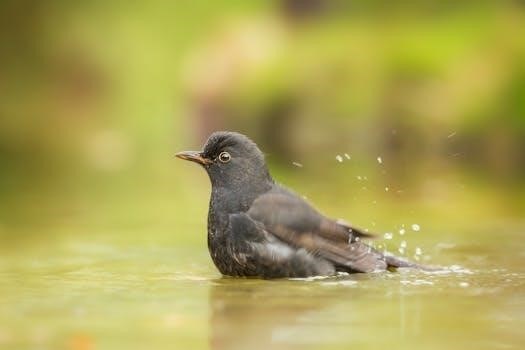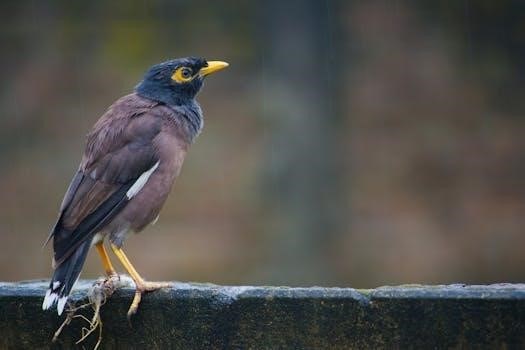hoffman bird guide
Ralph Hoffmann⁚ Life and Work
Ralph Hoffmann, born in 1870, was a multifaceted individual, serving as a principal, teacher, and author. He also distinguished himself as an ornithologist and botanist, contributing significantly to the field. Hoffmann even held the position of Museum Director.
Early Life and Education
Ralph Hoffmann’s life began in Stockbridge, Massachusetts, on November 30, 1870. His early years were spent in an environment that likely fostered his later interests in nature and the natural world. Details regarding his specific schooling are not widely documented, but it is known that he pursued higher education, developing a strong foundation in academics. This educational background provided the necessary skills for his future roles as an educator and author. A key aspect of his academic training included a deep understanding of Latin, a skill that likely influenced his scientific writings and publications. This early life and education laid the groundwork for his subsequent contributions to ornithology and education, shaping his approach to both fields.

Career as Educator and Ornithologist

Hoffmann’s career was marked by his dual roles as an educator and an ornithologist. He spent a significant portion of his life working as a principal and teacher, demonstrating his commitment to sharing knowledge. Alongside his educational career, Hoffmann cultivated a deep passion for birds, becoming a respected ornithologist. His approach to studying birds was unique, focusing on field observations rather than solely relying on museum specimens. This hands-on approach led to a greater understanding of bird behavior, habitat, and vocalizations. Hoffmann’s experience as an educator likely influenced his ability to communicate complex ornithological concepts in an accessible way, making him a pivotal figure in popularizing birdwatching. His dual career path enriched his contributions to both education and the understanding of avian life.
Contributions to Ornithology
Hoffmann’s significant contributions to ornithology stem from his focus on practical field identification techniques. He moved away from traditional methods that relied heavily on detailed descriptions of preserved specimens. Instead, Hoffmann championed the importance of observing birds in their natural habitats. He emphasized the use of field marks, behavioral patterns, habitat preferences, and vocalizations as key elements in identifying birds. This approach revolutionized birdwatching, shifting the focus to learning birds through direct observation in nature. His detailed observations and descriptions laid the groundwork for modern field guides, making it easier for both amateur and professional ornithologists to identify birds accurately. Hoffmann’s work helped transform the study of birds into a more accessible and engaging activity for a wider audience.

Hoffmann’s “A Guide to the Birds of New England and Eastern New York”
Published in 1904, this book marked a turning point in bird identification. It focused on field identification, using behavior, habitat, and vocalizations as key tools.
Publication and Significance
Ralph Hoffmann’s “A Guide to the Birds of New England and Eastern New York,” released in 1904, was a groundbreaking publication. It was unprecedented in its approach, shifting the focus from museum specimens to live birds in their natural habitats. The guide provided a key for each season and descriptions of over 250 species. This work prioritized field marks, behavior, habitat, and vocalizations, facilitating identification in the field. Hoffmann’s book became a cornerstone for birders in the region and is considered a key text in the evolution of modern field guides. It stood out for its detailed information and practical approach, which set it apart from previous works that primarily focused on technical descriptions and taxonomy. The guide is recognized as a significant contribution to ornithology, offering a user-friendly resource to identify birds in their natural settings, rather than just based on their appearance in a laboratory.
Focus on Field Identification
Hoffmann’s guide placed a strong emphasis on field identification, a novel approach for its time. Unlike previous guides that relied heavily on technical descriptions and museum specimens, Hoffmann focused on enabling birders to identify birds in their natural environments. He stressed the importance of observing key characteristics such as field marks, behavioral patterns, preferred habitats, and unique vocalizations. This shift towards practical, in-the-field identification marked a significant departure from traditional ornithological literature. Hoffmann’s goal was to empower bird watchers to recognize birds through direct observation, rather than relying on static images or descriptions. This emphasis made birding more accessible and enjoyable for a wider audience. His guide provided a practical methodology for identifying birds based on their behavior, habitat and calls, encouraging firsthand experience.
Use of Field Marks
Hoffmann’s guide meticulously detailed the use of field marks, highlighting their importance in accurate bird identification. He understood that subtle visual cues, often overlooked in traditional descriptions, were crucial for distinguishing between similar species in the field. These field marks included specific patterns of plumage, such as wing bars, eye stripes, and tail patterns. Hoffmann emphasized that these marks are often more readily apparent than overall coloration. He encouraged birders to pay close attention to these distinguishing features, providing clear descriptions and guidance on how to spot them quickly. By focusing on these specific details, Hoffmann made it easier for even novice birders to confidently identify various species. This focus on field marks became a hallmark of modern field guides, greatly influencing how bird identification is approached.
Behavioral Observations
Beyond physical characteristics, Hoffmann stressed the significance of behavioral observations in bird identification. He recognized that a bird’s behavior, including its feeding habits, foraging techniques, and flight patterns, could provide critical clues to its identity. Hoffmann’s guide detailed how different species exhibited distinct behaviors, such as the way a particular bird might hop, perch, or interact with its environment. He encouraged observers to note if a bird typically foraged on the ground, in trees, or in the water. He also described their unique movements, like the way some birds flick their tails or bob their heads. By integrating behavioral information with field marks, Hoffmann created a more holistic approach to bird identification, enabling observers to gain a deeper understanding of the birds they were watching and improving their accuracy in identification.
Habitat and Vocalizations
Hoffmann emphasized the importance of habitat and vocalizations in bird identification. He understood that certain bird species are found in particular environments, such as forests, marshes, or open fields. Therefore, knowing the preferred habitat of a bird could narrow down identification possibilities. Furthermore, Hoffmann meticulously detailed the various calls and songs of birds, recognizing that these sounds often provide the most reliable method for distinguishing one species from another. He described the nuances of each bird’s vocalizations, including call notes and songs, and how they varied according to the season or circumstance. By combining habitat information with an understanding of vocalizations, Hoffmann created a more thorough system for bird identification, making it easier for birders to accurately identify birds in the field using all available clues.
Impact on Birdwatching
Hoffmann’s work significantly impacted birdwatching by shifting its focus from specimen collection to field identification. His “A Guide to the Birds of New England and Eastern New York” empowered amateur birders to identify birds in their natural habitats using observable characteristics rather than relying on captured specimens. This approach fostered a more ethical and conservation-minded approach to birding. By emphasizing field marks, behavior, habitat, and vocalizations, Hoffmann made bird identification more accessible to the general public, promoting a wider appreciation and understanding of avian diversity. His guide served as a catalyst for the growth of birdwatching as a popular recreational activity and contributed to the development of modern field guides that still shape bird identification methods today.

Modern Bird Identification and Resources
Today, bird identification utilizes advanced tools. Field guides have evolved, and digital resources like the Merlin Bird ID app and Cornell Lab of Ornithology provide accessible identification support, making birding more convenient.
Field Guides and Their Evolution
Field guides have undergone a significant transformation over time, moving from text-heavy descriptions to visually rich resources. Early guides often relied on detailed written accounts, which could be cumbersome for quick identification in the field. The work of pioneers like Ralph Hoffmann, with his focus on observable traits like field marks and behavior, paved the way for more practical guides. Modern field guides emphasize illustrations and photographs, enabling birders to easily compare visual characteristics. These guides often include range maps, vocalization descriptions, and habitat preferences, providing a comprehensive picture of each species. The evolution of field guides reflects a continuous effort to make bird identification more efficient and accessible to a wider audience. Today, field guides are crucial tools for both beginners and experienced birders, aiding in accurate and enjoyable birdwatching experiences. They are portable and durable, allowing nature enthusiasts to learn about birds anywhere.
Digital Bird Identification Tools
The advent of digital technology has revolutionized bird identification, offering powerful tools for both novice and experienced birders. Digital resources, such as apps and online databases, provide instant access to a wealth of information, including photos, range maps, and audio recordings of bird songs and calls. These tools often employ advanced features like image recognition and sound analysis, allowing users to identify birds based on photos or recordings. The Merlin Bird ID app, for example, utilizes computer vision to identify birds from photos and sound recordings and can help users to identify birds using a step-by-step method. The Cornell Lab of Ornithology also provides an extensive online database with information on various bird species. These digital tools are constantly updated, incorporating new research and improved features, making bird identification more accessible and engaging than ever before. This advancement is very useful to everyone.
Merlin Bird ID App
The Merlin Bird ID app, developed by the Cornell Lab of Ornithology, represents a significant advancement in digital bird identification. This app utilizes computer vision technology to identify birds from photographs, making it a valuable tool for those who may have difficulty recognizing birds in the field. Additionally, Merlin offers a sound identification feature, enabling users to identify birds by their songs or calls. The app is designed to be user-friendly, offering a step-by-step process to help individuals at all levels of experience, from beginners to expert birders, learn about different species. Merlin also includes a variety of resources, such as range maps and detailed descriptions, all within the app. It also offers a quick way to identify birds in any country. With its photo and sound ID capabilities, Merlin stands out as a powerful digital aid for birdwatchers.
Cornell Lab of Ornithology Resources
The Cornell Lab of Ornithology provides a wealth of online resources for bird enthusiasts. Their website features an extensive database of North American birds, complete with detailed information on species identification, life histories, and conservation statuses. Users can access a comprehensive bird guide that includes photographs, sounds, and videos of bird behavior. The lab also offers various tools to help with bird identification, such as a browse-by-shape feature and taxonomic classifications. Furthermore, they actively engage in conservation research, making their resources relevant and up-to-date. The Cornell Lab’s resources are invaluable for both beginner and experienced birders, providing a solid foundation for learning about avian life. The resources include a wealth of information and interactive tools. They are a great support to those trying to identify birds.
Tips for Beginner Birders
If you’re new to birdwatching, it’s best to start slow and build your knowledge gradually. Begin by studying the birds that visit your feeders until you can identify them easily at a glance. Then, slowly add more species to your repertoire, taking the time to learn their unique features; Focus on understanding their nuances. Sparrows, shorebirds, and gulls can be challenging, so don’t be discouraged if they take longer to master. Pay close attention to the key elements of bird identification, such as location, habitat, season, and behavior. Use field guides and apps like Merlin to assist you in the process. Remember that patience is key, and with practice, you will become more skilled at identifying birds.

